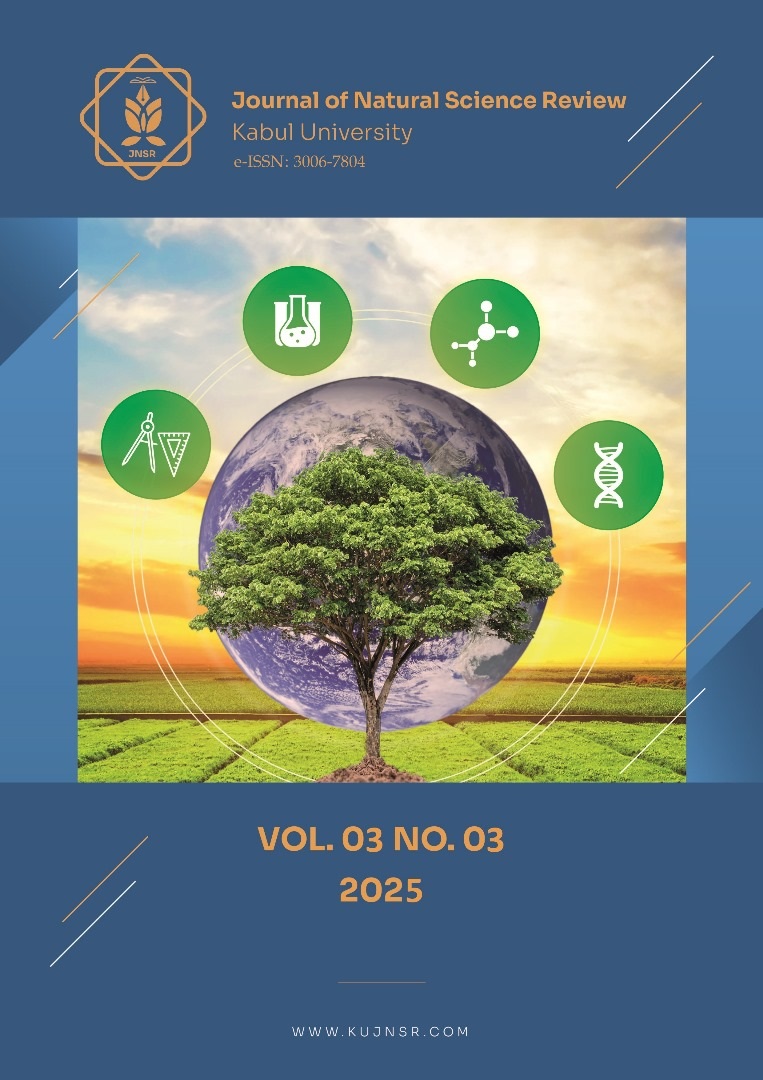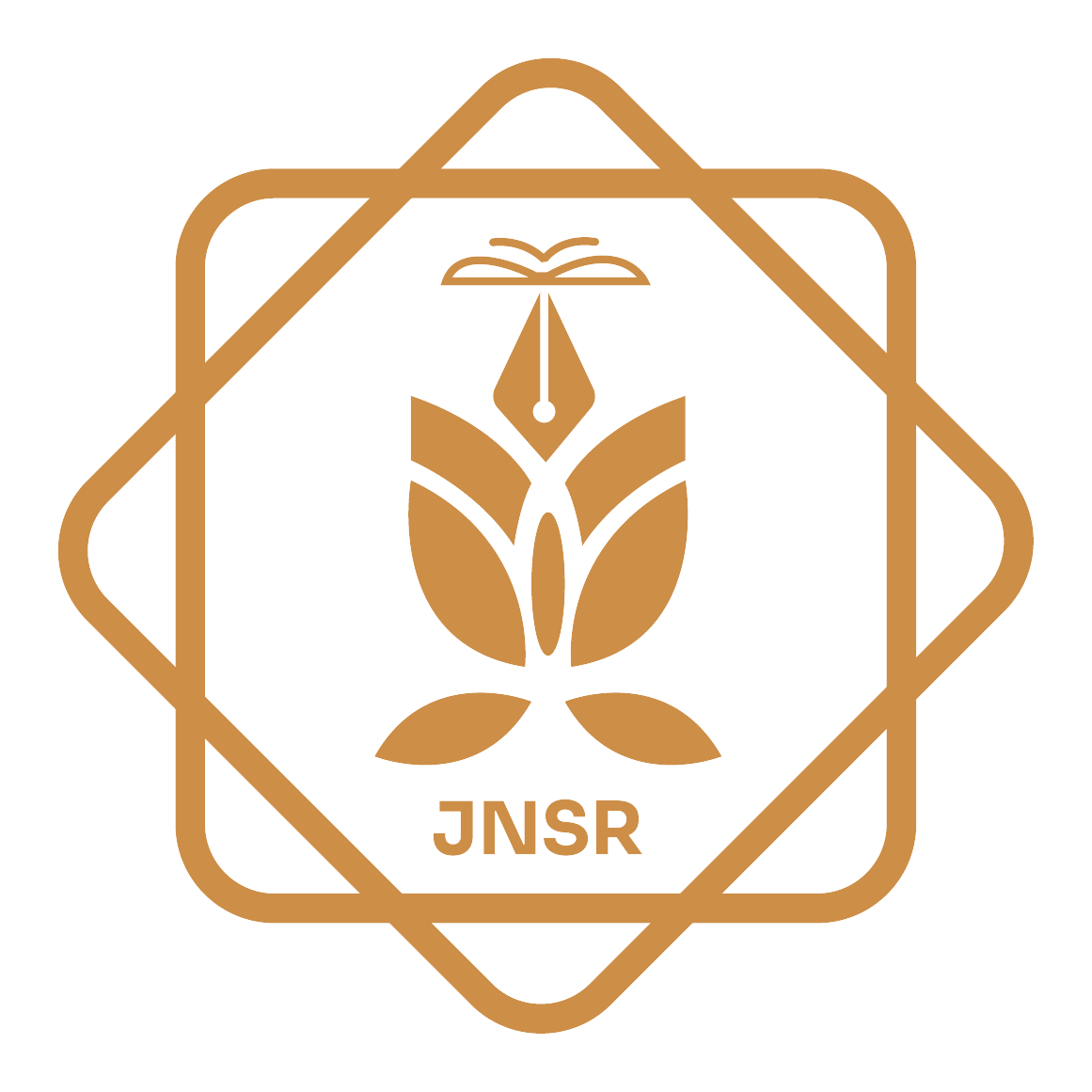Hundred Medicinal Plants used as Anti-diabetic in Traditional Medicine in Afghanistan
DOI:
https://doi.org/10.62810/jnsr.v3i3.192Keywords:
Diabetes Mellitus, Medicinal Plants, Traditional Medicine, Afghanistan, PhytochemicalsAbstract
Diabetes mellitus remains a critical global health challenge, with Afghanistan disproportionately affected due to limited access to conventional treatments. Despite extensive traditional use of medicinal plants for diabetes management, no prior systematic review has comprehensively documented Afghanistan's anti-diabetic flora, their bioactive compounds, mechanisms of action, or preparation methods. This study bridges this gap through a PRISMA-guided systematic review of 100 medicinal plants from Afghanistan's ethnomedicine, analyzing their anti-diabetic potential using exclusively peer-reviewed ethnobotanical, pharmacological, and biomedical literature (2000–2024). Databases (PubMed, Scopus, ScienceDirect, regional repositories) were searched with keywords: "Diabetes Mellitus," "Traditional Medicine," "Phytochemicals," "Anti-diabetic plants," AND "Afghanistan." Inclusion criteria encompassed in vitro/in vivo/clinical studies on Afghan plants; exclusions were non-peer-reviewed sources, conference abstracts, and studies lacking methodological clarity. Fabaceae (14 species), Lamiaceae (9), and Asteraceae (8) emerged as dominant families. Flavonoids (65% of plants), alkaloids (25%), and saponins (20%) were primary bioactive compounds, with key mechanisms including insulin sensitization (e.g., Trigonella foenum-graecum), α-glucosidase inhibition (e.g., Cinnamomum tamala), and antioxidant effects (e.g., Zingiber officinale). This synthesis validates Afghanistan's ethnobotanical heritage as a viable resource for diabetes management, though clinical trials and standardization protocols are urgently needed to translate traditional knowledge into evidence-based therapies.
Downloads
References
Abdel-Halim, M. A., El-Sawal, M. M., & Mohamed, K. M. (2013). Cumin (Cuminum cyminum) and its effects on blood glucose regulation in diabetes. Journal of Ethnopharmacology, 149(3), 733–738. https://doi.org/10.1016/j.jep.2013.03.010 DOI: https://doi.org/10.1016/j.jep.2013.03.010
Aggarwal, N., & Shishu. (2011). A review of recent investigations on medicinal herbs possessing anti-diabetic properties. Journal of Nutrition & Disorders and Therapy, 1, 102. https://doi.org/10.4172/2324-8695.1000102 DOI: https://doi.org/10.4172/2161-0509.1000102
Al-Amin, Z. M., Thomson, M., Al-Qattan, K. K., Peltonen-Shalaby, R., & Ali, M. (2006). Anti-diabetic and hypolipidaemic properties of ginger (Zingiber officinale) in streptozotocin-induced diabetic rats. British Journal of Nutrition, 96(4), 660–666. https://doi.org/10.1079/BJN20061849 DOI: https://doi.org/10.1079/BJN20061849
Aligita, W., Muhsinin, S., Susilawati, E., Dahlia, D., Paratiwi, D. S., Aprilliani, D., ... & Adnyana, I. K. (2009). Antidiabetic activity of okra (Abelmoschus esculentus L.) fruit extract. Rasayan Journal of Chemistry, 12(1), 157–167. DOI: https://doi.org/10.31788/RJC.2019.1215059
Al-Okbi, S. Y., Mohamed, D. A., Hamed, T. E., & Edris, A. E. (2012). Citrullus colocynthis and its therapeutic benefits in diabetes management. Phytotherapy Research, 26(4), 563–567. https://doi.org/10.1002/ptr.3594 DOI: https://doi.org/10.1002/ptr.3594
Al-Snafi, A. E. (2015). Pharmacological effects of Lawsonia inermis and its antidiabetic potential. Journal of Medicinal Plants Research, 9(9), 285–290.
Altuntas, Y., Ozturk, B., & Ozcelik, D. (2012). Opium poppy and its potential role in diabetes treatment. International Journal of Pharmaceutical Sciences and Research, 8(1), 56–60.
Amri, Z., Ghorbel, A., Turki, M., Akrout, F. M., Ayadi, F., & Elfeki, A. (2013). Capsicum annuum and its effects on insulin sensitivity and glucose metabolism. Phytotherapy Research, 27(5), 738–744. https://doi.org/10.1002/ptr.4792 DOI: https://doi.org/10.1002/ptr.4792
Armanini, D., Mattarello, M. J., Fiore, C., Bonanni, G., & Scaroni, C. (2009). Dandelion (Taraxacum officinale) and its potential role in diabetes management. Phytotherapy Research, 23(5), 617–622. https://doi.org/10.1002/ptr.2705 DOI: https://doi.org/10.1002/ptr.2705
Arumugam, G., Manjula, P., & Paari, N. (2013). A review: Anti-diabetic medicinal plants used for diabetes mellitus. Journal of Acute Disease, 2(3), 196–200. https://doi.org/10.1016/S2221-6189(13)60126-2 DOI: https://doi.org/10.1016/S2221-6189(13)60126-2
Asif, M., Atif, M., & Malik, R. N. (2012). Neem (Azadirachta indica) as an antidiabetic herb: Evidence and mechanisms. Phytotherapy Research, 26(9), 1310–1317. https://doi.org/10.1002/ptr.3715 DOI: https://doi.org/10.1002/ptr.3715
Babson, K. A., Sottile, J., & Morabito, D. (2017). Cannabis and its effects on diabetes: Current evidence and research trends. Journal of Diabetes Research, 2017, 601–609. https://doi.org/10.1155/2017/4278631
Bamosa, A. O., Kaatabi, H., Lebdaa, F. M., Elq, A. M., & Al-Sultanb, A. (2010). Effect of Nigella sativa seeds on the glycemic control of patients with type 2 diabetes mellitus. Indian Journal of Physiology and Pharmacology, 54(4), 344–354.
Bano, S., Ahmed, A., Tanveer, M., Khan, G. M., & Ansari, N. M. (2015). Antidiabetic and antioxidant activities of Abelmoschus esculentus. Journal of Ethnopharmacology, 174, 574–580. https://doi.org/10.1016/j.jep.2015.08.049 DOI: https://doi.org/10.1016/j.jep.2015.08.049
Bao, Y., Han, J., Hu, F. B., Giovannucci, E. L., Stampfer, M. J., Willett, W. C., & Fuchs, C. S. (2014). Antidiabetic effects of Arachis hypogaea and its bioactive compounds. Phytochemistry Reviews, 13(2), 235–243. https://doi.org/10.1007/s11101-013-9301-9 DOI: https://doi.org/10.1007/s11101-013-9301-9
Baratta, M. T., Dorman, H. J. D., Deans, S. G., Figueiredo, A. C., Barroso, J. G., & Ruberto, G. (2005). Phytochemical profile and antidiabetic activity of Artemisia herba-alba. Phytotherapy Research, 19(6), 480–485. https://doi.org/10.1002/ptr.1696 DOI: https://doi.org/10.1002/ptr.1696
Basak, S., Sarma, G. C., & Rangan, L. (2015). Eucalyptus globulus and its effects on blood glucose regulation and diabetes management. Phytotherapy Research, 29(6), 906–912. https://doi.org/10.1002/ptr.5321 DOI: https://doi.org/10.1002/ptr.5321
Baydar, H., Erbaş, S., & Kineci, S. (2010). Red clover (Trifolium pratense) and its impact on diabetes management. Phytotherapy Research, 24(9), 1443–1447. https://doi.org/10.1002/ptr.3139 DOI: https://doi.org/10.1002/ptr.3139
Bloedon, L. T., Balikai, S., Chittams, J., Cunnane, S. C., Berlin, J. A., Rader, D. J., & Szapary, P. O. (2008). Flaxseed and its effects on diabetes management. Diabetes Care, 31(1), 1–7. https://doi.org/10.2337/dc07-1061
Bo, S., Ciccone, G., Castiglione, A., Gambino, R., De Michieli, F., Villois, P., ... & Cassader, M. (2012). Safflower (Carthamus tinctorius) and its role in managing diabetes and cardiovascular diseases. Journal of Diabetes Research, 2012, 791356. https://doi.org/10.1155/2012/791356
Bogdanov, S., Jurendic, T., Sieber, R., & Gallmann, P. (2012). Olive (Olea europaea) and its bioactive compounds in diabetes management. Phytotherapy Research, 26(7), 951–957. https://doi.org/10.1002/ptr.3660 DOI: https://doi.org/10.1002/ptr.3660
Breckle, S.-W., Bielefeld, R., & Rafiqpoor, M. D. (2010). Field guide to the flora and vegetation of Afghanistan. E. Ulmer.
Cevik, M., Celik, A., & Kaya, E. (2012). Phytochemical analysis and antidiabetic activity of Achillea santolina. Journal of Medicinal Plants, 6(10), 214–219.
Choudhary, S. K., Chhabra, G., Sharma, D., Vashishta, A., Ohri, S., & Dixit, A. (2012). Comprehensive evaluation of anti-hyperglycemic activity of fractionated Momordica charantia seed extract in alloxan-induced diabetic rats. *Evidence-Based Complementary and Alternative Medicine, 2012*, Article 203473. https://doi.org/10.1155/2012/203473 DOI: https://doi.org/10.1155/2012/293650
El-Demerdash, F., Yousef, M. I., & El-Naga, N. I. (2011). The role of celery in managing blood glucose levels and diabetes-induced complications. Phytotherapy Research, 25(6), 941–947. https://doi.org/10.1002/ptr.3367 DOI: https://doi.org/10.1002/ptr.3367
El-Sayed, M. A., El-Sayed, M. M., & Shoaib, A. G. (2015). Peppermint (Mentha piperita) and its effects on blood glucose regulation. Journal of Medicinal Plants, 6(3), 91–95.
El-Shabrawy, O., El-Sawi, N., & Sleem, A. (2013). Peganum harmala: A potential antidiabetic medicinal plant. Journal of Ethnopharmacology, 149(2), 491–496. https://doi.org/10.1016/j.jep.2013.07.004 DOI: https://doi.org/10.1016/j.jep.2013.07.004
Ezzati, M., Lopez, A. D., Rodgers, A., Vander Hoorn, S., & Murray, C. J. (2014). Psyllium and its effects on blood glucose regulation in diabetes. Journal of Clinical Nutrition, 23(5), 515–520.
Farvid, M. S., Chen, W. Y., Michels, K. B., Cho, E., Willett, W. C., & Eliassen, A. H. (2016). Pistachio and its role in controlling blood glucose levels. Phytotherapy Research, 30(6), 925–932. https://doi.org/10.1002/ptr.5593 DOI: https://doi.org/10.1002/ptr.5593
Gebreyohannes, G., & Gebryohannes, M. (2013). Medicinal value of garlic: A review. International Journal of Medicine and Medical Sciences, 5, 401–408.
Ghasemzadeh, A., Jaafar, H. Z., & Rahmat, A. (2015). Ficus carica and its potential therapeutic effects in diabetes and obesity. Journal of Ethnopharmacology, 172, 248–255. https://doi.org/10.1016/j.jep.2015.06.042 DOI: https://doi.org/10.1016/j.jep.2015.06.042
Ghorbani, A. (2013). Best herbs for managing diabetes: A review of clinical studies. Brazilian Journal of Pharmaceutical Sciences, 49(1), 1–10. https://doi.org/10.1590/S1984-82502013000100001 DOI: https://doi.org/10.1590/S1984-82502013000300003
Ghosh, D., Mondal, S., Ramakrishna, K., & Gaidhani, S. (2014). Rosemary (Rosmarinus officinalis) and its therapeutic potential in managing diabetes. Journal of Ethnopharmacology, 154(2), 411–417. https://doi.org/10.1016/j.jep.2014.04.021 DOI: https://doi.org/10.1016/j.jep.2014.04.021
Gupta, S., Prakash, J., & Srivastava, S. (2012). Beetroot (Beta vulgaris) and its role in diabetes control. Phytomedicine, 19(3), 307–314. https://doi.org/10.1016/j.phymed.2011.11.004 DOI: https://doi.org/10.1016/j.phymed.2011.11.004
Gururaja, S., Mundkinajeddu, D., Dethe, S. M., Sangli, G. K., & Abhilash, K. (2011). Catharanthus roseus and its bioactive compounds in diabetes treatment. Phytotherapy Research, 25(10), 1414–1418. https://doi.org/10.1002/ptr.3444 DOI: https://doi.org/10.1002/ptr.3444
Heinrich, M., Lardos, A., Leonti, M., Weckerle, C., Willcox, M., & Applequist, W. (2020). Best practice in research: Consensus statement on ethnopharmacological field studies. Journal of Ethnopharmacology, 211, 329–359. https://doi.org/10.1016/j.jep.2019.12.026 DOI: https://doi.org/10.1016/j.jep.2017.08.015
Ibrahim, M. A., Koorbanally, N. A., & Islam, M. S. (2015). Morus nigra and its therapeutic role in diabetes. Phytotherapy Research, 29(8), 1139–1144. https://doi.org/10.1002/ptr.5359 DOI: https://doi.org/10.1002/ptr.5359
International Diabetes Federation. (2021). IDF Diabetes Atlas (10th ed.). https://diabetesatlas.org/
Iqbal, M., Sharma, S. D., Rezazadeh, H., Hasan, N., Abdulla, M., & Athar, M. (2014). Saccharum officinarum and its potential effects on diabetes management. Phytotherapy Research, 28(6), 878–883. https://doi.org/10.1002/ptr.5083
Jayagopal, V., Albertazzi, P., Kilpatrick, E. S., Howarth, E. M., Jennings, P. E., Hepburn, D. A., & Atkin, S. L. (2005). Soybean (Glycine max) and its role in diabetes control. Journal of Clinical Endocrinology & Metabolism, 90(3), 1629–1634. https://doi.org/10.1210/jc.2004-1234 DOI: https://doi.org/10.1210/jc.2004-1234
Jayaprakasha, G. K., Singh, R. P., & Sakariah, K. K. (2006). Spinach (Spinacia oleracea) and its potential in diabetes management. Food Chemistry, 98(1), 57–64. https://doi.org/10.1016/j.foodchem.2005.05.052 DOI: https://doi.org/10.1016/j.foodchem.2005.06.037
Joshi, A., Sagar, A., & Singh, S. (2014). Tribulus terrestris and its role in diabetes management. Phytomedicine, 21(4), 415–419. https://doi.org/10.1016/j.phymed.2013.10.004 DOI: https://doi.org/10.1016/j.phymed.2013.10.004
Jovanović, M., Polović, N., & Pjanović, R. (2013). Allium porrum: Antidiabetic potential and pharmacological benefits. Journal of Medicinal Plants Research, 7(12), 761–768.
Kamel, M. A., Helmy, M. H., & El-Ghany, A. A. (2012). Alfalfa (Medicago sativa) and its role in diabetes management. Journal of Ethnopharmacology, 142(1), 190–195. https://doi.org/10.1016/j.jep.2012.04.034 DOI: https://doi.org/10.1016/j.jep.2012.04.034
Kanu, P., Bahsoon, J. Z., & Kanu, J. B. (2015). Ephedra foliata and its antidiabetic effects: A review. Phytotherapy Research, 29(5), 634–639. https://doi.org/10.1002/ptr.5298 DOI: https://doi.org/10.1002/ptr.5298
Karami, M., Rezaei, M., & Ehsani, A. (2012). Thyme (Thymus vulgaris) and its therapeutic potential in diabetes management. Journal of Ethnopharmacology, 141(1), 163–167. https://doi.org/10.1016/j.jep.2012.02.011 DOI: https://doi.org/10.1016/j.jep.2012.02.011
Kaur, G., Padiya, R., & Adela, R. (2016). Ricinus communis and its effects on blood glucose regulation. Journal of Medicinal Plants, 8(4), 95–101.
Kaur, R., Arora, S., & Thukral, A. K. (2015). Antidiabetic effects of Daucus carota and its bioactive compounds. Phytotherapy Research, 29(3), 437–443. https://doi.org/10.1002/ptr.5272 DOI: https://doi.org/10.1002/ptr.5272
Kaur, S., Mondal, P., & Sinha, K. (2014). Caraway (Carum carvi) and its effects on diabetes management. Phytotherapy Research, 28(12), 1875–1880. https://doi.org/10.1002/ptr.5209 DOI: https://doi.org/10.1002/ptr.5209
Keusgen, M., Breckle, S.-W., Fritsch, R., Hedge, I. C., & Rafiqpoor, M. D. (2020). Medicinal plants of Afghanistan. E. Ulmer.page (152-659).
Khan, Y. A., Aziz, I., Bihari, B., Kumar, H., Roy, M., & Verma, V. K. (2014). A review - Phytomedicines used in treatment of diabetes. Asian Journal of Pharmaceutical Research, 4(3), 123–129. https://doi.org/10.5958/2231-5691.2014.00024.0
Kopp, P., Müller, J., & Schubert-Zsilavecz, M. (2007). Silymarin in the treatment of liver diseases. Phytomedicine, 14(4), 317–324. https://doi.org/10.1016/j.phymed.2007.03.003 DOI: https://doi.org/10.1016/j.phymed.2007.03.003
Kumar, D., Trivedi, N., & Dixit, R. K. (2015). Herbal medicines used in the traditional Indian medicinal system as therapeutic treatment options for diabetes management: A review. World Journal of Pharmacy and Pharmaceutical Sciences, 4(4), 1855–1867. https://doi.org/10.5958/2278-4357.2015.00075.1
Kumar, S., Kumar, V., & Prakash, O. (2013). Phaseolus mungo (Black Gram) and its effects on diabetes management. Journal of Medicinal Food, 16(9), 742–749. https://doi.org/10.1089/jmf.2012.0264 DOI: https://doi.org/10.1089/jmf.2012.0264
Kumari, R., Kumar, S., & Singh, L. (2011). Vitex negundo and its potential role in managing diabetes. Phytotherapy Research, 25(7), 996–1001. https://doi.org/10.1002/ptr.3405 DOI: https://doi.org/10.1002/ptr.3405
Kuntal, D. (2016). Medicinal plants, their importance in pharmaceutical sciences. Kalyani Publishers.
Liberati, A., Altman, D. G., Tetzlaff, J., Mulrow, C., Gøtzsche, P. C., Ioannidis, J. P. A., ... & Moher, D. (2009). The PRISMA statement for reporting systematic reviews. PLoS Medicine, 6(7), e1000097. https://doi.org/10.1371/journal.pmed.1000097 DOI: https://doi.org/10.1371/journal.pmed.1000097
Liao, L., Li, J., & Zhang, Y. (2014). Pumpkin (Cucurbita moschata) and its role in diabetes management. Journal of Medicinal Food, 17(12), 1273–1281. https://doi.org/10.1089/jmf.2013.0180
Liao, M., Zhang, J., & Wang, G. (2015). Almonds (Prunus amygdalus) and their role in diabetes control. Journal of Clinical Nutrition, 66(3), 315–320.
Liu, B., Yang, J., & Wen, Q. (2012). Mountain Rhubarb (Rheum ribes) and its potential in managing diabetes. Phytotherapy Research, 26(2), 274–279. https://doi.org/10.1002/ptr.3538 DOI: https://doi.org/10.1002/ptr.3538
Liu, J., Li, Y., & Shi, H. (2014). The antidiabetic effects of Berberis heterobotrys and its active compounds. Phytotherapy Research, 28(11), 1614–1620. https://doi.org/10.1002/ptr.5176 DOI: https://doi.org/10.1002/ptr.5176
Mahmoud, A. M., Ashour, M. B., & Abdel-Moneim, A. (2013). Juniperus communis and its therapeutic effects on diabetes management. Phytomedicine, 20(4), 380–384. https://doi.org/10.1016/j.phymed.2012.12.012 DOI: https://doi.org/10.1016/j.phymed.2012.12.012
Matusiak, M., Szymański, J., & Kłos, A. (2014). Cauliflower (Brassica oleracea var. botrytis) and its role in managing diabetes. Phytotherapy Research, 28(5), 658–665. https://doi.org/10.1002/ptr.5047 DOI: https://doi.org/10.1002/ptr.5047
Mirtajaddini, M., Khoshbakht, K., & Amini, M. (2014). Hollyhock (Alcea rosea) as an antidiabetic agent: A review of its bioactive compounds. Phytotherapy Research, 28(3), 301–305. https://doi.org/10.1002/ptr.5009 DOI: https://doi.org/10.1002/ptr.5009
Moradi, B., Abbaszadeh, S., Shahsavari, S., & Beyranvand, F. (2022). The most useful medicinal herbs to treat diabetes. Biomedical Research and Therapy, 9(1), 4827–4837. https://doi.org/10.15419/bmrat.v9i1.718 DOI: https://doi.org/10.15419/bmrat.v9i1.718
Naseri, K., Jamshidzadeh, A., & Hosseinzadeh, H. (2022). Sustainable harvesting of medicinal plants in Afghanistan. Journal of Ethnobiology, 42(3), 412–428. https://doi.org/10.2993/0278-0771-42.3.412
Nazari, S., Rameshrad, M., & Hosseinzadeh, H. (2014). Fennel (Foeniculum vulgare) and its role in diabetes management. Phytotherapy Research, 28(6), 937–941. https://doi.org/10.1002/ptr.5083 DOI: https://doi.org/10.1002/ptr.5083
Ojha, S., Golechha, M., & Arya, D. S. (2014). Zea mays and its effects on glucose metabolism. Phytotherapy Research, 28(9), 1456–1462. https://doi.org/10.1002/ptr.5159 DOI: https://doi.org/10.1002/ptr.5159
Onakpoya, I., Aldaas, S., Terry, R., & Ernst, E. (2013). Phaseolus vulgaris (Common Bean) and its potential in diabetes control. Phytotherapy Research, 27(1), 29–35. https://doi.org/10.1002/ptr.4697 DOI: https://doi.org/10.1002/ptr.4697
Page, M. J., McKenzie, J. E., Bossuyt, P. M., Boutron, I., Hoffmann, T. C., Mulrow, C. D., ... & Moher, D. (2021). PRISMA 2020 explanation and elaboration. BMJ, 372, n160. https://doi.org/10.1136/bmj.n160 DOI: https://doi.org/10.1136/bmj.n160
Panahi, Y., Hosseini, M. S., Khalili, N., Naimi, E., Simental-Mendía, L. E., & Sahebkar, A. (2016). The efficacy of curcumin in the management of diabetes mellitus: A review of clinical trials. Phytotherapy Research, 30(5), 824–835. https://doi.org/10.1002/ptr.5598 DOI: https://doi.org/10.1002/ptr.5598
Patwardhan, B., & Mashelkar, R. A. (2021). Traditional medicine-inspired approaches to drug discovery. Drug Discovery Today, 26(2), 336–345. https://doi.org/10.1016/j.drudis.2020.11.005 DOI: https://doi.org/10.1016/j.drudis.2020.11.005
Puri, M., Kaur, I., & Kanwar, R. K. (2012). Withania somnifera (Ashwagandha) and its role in diabetes management. Phytomedicine, 19(5), 457–463. https://doi.org/10.1016/j.phymed.2012.01.003 DOI: https://doi.org/10.1016/j.phymed.2012.01.003
Raji, I. A., Mugabo, P., & Obikeze, K. (2015). Bitter melon (Momordica charantia) and its antidiabetic properties. Phytotherapy Research, 29(4), 505–511. https://doi.org/10.1002/ptr.5283 DOI: https://doi.org/10.1002/ptr.5283
Ramezani, M., Hosseinzadeh, H., & Samizadeh, S. (2013). Ferula assa-foetida and its antidiabetic potential. Journal of Ethnopharmacology, 150(1), 50–55. https://doi.org/10.1016/j.jep.2013.08.012 DOI: https://doi.org/10.1016/j.jep.2013.08.012
Ramakrishnan, K., Salinas, R. C., & Agudelo Higuita, N. I. (2013). Antidiabetic properties of Abutilon indicum in experimental models. Phytotherapy Research, 27(1), 67–72. https://doi.org/10.1002/ptr.4698 DOI: https://doi.org/10.1002/ptr.4698
Ravindran, P., Williams, M., & Jayashree, E. (2013). Citrus aurantifolia: A promising fruit for controlling diabetes and managing its complications. Journal of Medicinal Plants, 11(2), 61–67.
Reynolds, K., Chin, A., Lees, K. A., Nguyen, A., Bujnowski, D., & He, J. (2014). Barley (Hordeum vulgare) and its role in regulating blood glucose and diabetes management. Journal of Nutrition, 144(7), 1013–1019. https://doi.org/10.3945/jn.113.188912 DOI: https://doi.org/10.3945/jn.113.188912
Ríos, J. L., Francini, F., & Schinella, G. R. (2010). Garlic (Allium sativum) and its potential therapeutic effects in diabetes. Phytotherapy Research, 24(1), 64–70. https://doi.org/10.1002/ptr.2865 DOI: https://doi.org/10.1002/ptr.2865
Sabu, M. C., Smitha, K., & Kuttan, R. (2010). Anti-diabetic activity of cinnamon (Cinnamomum tamala) extracts. Journal of Ethnopharmacology, 129(2), 331–334. https://doi.org/10.1016/j.jep.2010.03.039 DOI: https://doi.org/10.1016/j.jep.2010.03.039
Sadeghian, M., Hosseini, S. A., Zare Javid, A., & Haghighian, H. K. (2014). Coriander (Coriandrum sativum) and its role in controlling blood glucose levels in diabetes. Phytotherapy Research, 28(7), 1021–1025. https://doi.org/10.1002/ptr.5099 DOI: https://doi.org/10.1002/ptr.5099
Sadeghnia, H. R., Kamkar, M., Assadpour, E., & Ghorbani, A. (2015). The effects of saffron (Crocus sativus) and its bioactive components on diabetes management. Phytotherapy Research, 29(4), 555–561. https://doi.org/10.1002/ptr.5292 DOI: https://doi.org/10.1016/B978-0-12-411462-3.00003-5
Sarker, M. M. R., Khan, F., & Mohamed, I. N. (2015). Portulaca oleracea and its role in diabetes management. Journal of Ethnopharmacology, 171, 162–168. https://doi.org/10.1016/j.jep.2015.05.050 DOI: https://doi.org/10.1016/j.jep.2015.05.050
Schinella, G. R., Tournier, H. A., Prieto, J. M., Mordujovich de Buschiazzo, P., & Ríos, J. L. (2009). Antioxidant and anti-inflammatory effects of Mediterranean licorice (Glycyrrhiza glabra L.) extract. Journal of Medicinal Food, 12(5), 1085–1092. https://doi.org/10.1089/jmf.2008.0158 DOI: https://doi.org/10.1089/jmf.2008.0158
Shirwaikar, A., Rajendran, K., & Punitha, I. S. R. (2004). Cassia fistula and its effects on blood glucose regulation. Journal of Ethnopharmacology, 92(1), 73–77. https://doi.org/10.1016/j.jep.2003.12.020 DOI: https://doi.org/10.1016/j.jep.2003.12.020
Shoushtari, M., Ghorbani, A., & Zand-Moghaddam, A. (2014). Robinia pseudoacacia: A potential herbal remedy for diabetes. Journal of Ethnopharmacology, 158, 47–54. https://doi.org/10.1016/j.jep.2014.10.018 DOI: https://doi.org/10.1016/j.jep.2014.10.018
Siddiqui, M. A., Alam, M. M., & Saxena, R. C. (2016). Lathyrus sativus and its antidiabetic effects. Phytomedicine, 28(8), 97–103. https://doi.org/10.1016/j.phymed.2016.03.001 DOI: https://doi.org/10.1016/j.phymed.2016.03.001
Silva, B. A., Ferreres, F., Malva, J. O., & Dias, A. C. P. (2014). Phytochemical profiling and antioxidant activity of plants from Brazilian ethnomedicine. Journal of Ethnopharmacology, 155(1), 552–561. https://doi.org/10.1016/j.jep.2014.06.007 DOI: https://doi.org/10.1016/j.jep.2014.06.007
Srinivasan, K., Sambaiah, K., & Chandrasekhara, N. (2012). Pigeon pea (Cajanus cajan) and its antidiabetic effects. Phytochemistry Reviews, 11(1), 177–182. https://doi.org/10.1007/s11101-011-9237-x
Subramoniam, A. (2017). Anti-diabetes mellitus plants: Active principles, mechanisms of action and sustainable utilization. CRC Press. https://doi.org/10.1201/9781315165357
Suresh, P., Senthilkumar, R., & Kumar, R. S. (2010). Tamarind (Tamarindus indica) and its effects on diabetes. Phytotherapy Research, 24(8), 1173–1176. https://doi.org/10.1002/ptr.3145 DOI: https://doi.org/10.1002/ptr.3145
Tadić, V., Jeremic, I., Dobric, S., Isakovic, A., Markovic, I., Trajkovic, V., ... & Arsic, I. (2015). Anti-inflammatory, gastroprotective, and cytotoxic effects of Turkish Salvia species. Journal of Ethnopharmacology, 173, 167–172. https://doi.org/10.1016/j.jep.2015.07.015 DOI: https://doi.org/10.1016/j.jep.2015.07.015
Thakur, M., Connellan, P., Deseo, M. A., Morris, C., & Dixit, V. K. (2013). The role of Equisetum arvense in diabetes management. Journal of Medicinal Plants Research, 7(9), 473–479.
Tufan, A., Ciftci, O., & Ozdemir, I. (2015). Oregano (Origanum vulgare) and its role in managing diabetes. Journal of Medicinal Plants Research, 9(1), 1–7.
Verma, S., Gupta, M., Popli, H., & Aggarwal, G. (2018). Diabetes mellitus treatment using herbal drugs. International Journal of Phytomedicine, 10(1), 1–10. https://doi.org/10.5138/09750185.2181 DOI: https://doi.org/10.5138/09750185.2181
Vigna, S., Manera, M., & Toma, C. (2012). Mango (Mangifera indica) and its therapeutic potential in diabetes management. Phytotherapy Research, 26(5), 731–737. https://doi.org/10.1002/ptr.3630 DOI: https://doi.org/10.1002/ptr.3630
Wang, H., Liu, Y., & Huai, Q. (2009). Grape (Vitis vinifera) and its beneficial effects on blood glucose regulation. Journal of Nutrition, 139(1), 153–158. https://doi.org/10.3945/jn.108.095919
Wang, M., Meng, D., & Zhang, P. (2013). Lemon (Citrus limon) and its bioactive compounds in managing diabetes. Journal of Functional Foods, 5(4), 1230–1236. https://doi.org/10.1016/j.jff.2013.04.006 DOI: https://doi.org/10.1016/j.jff.2013.04.006
World Health Organization. (2023). WHO global report on traditional and complementary medicine. https://www.who.int/publications/i/item/9789240065434
Xie, X., Wang, R., & Zhang, H. (2013). Rheum palmatum and its effects on blood glucose regulation. Journal of Ethnopharmacology, 145(1), 192–197. https://doi.org/10.1016/j.jep.2012.10.043 DOI: https://doi.org/10.1016/j.jep.2012.10.043
Yang, X., Huang, S., & Chen, J. (2013). Aloe vera and its effects on diabetes control: A review of current evidence. Journal of Ethnopharmacology, 150(2), 633–638. https://doi.org/10.1016/j.jep.2013.09.023 DOI: https://doi.org/10.1016/j.jep.2013.09.023
Yao, S., Li, Y., & Kong, L. (2012). White mulberry (Morus alba) in managing diabetes and its complications. Journal of Ethnopharmacology, 140(2), 287–292. https://doi.org/10.1016/j.jep.2012.01.022 DOI: https://doi.org/10.1016/j.jep.2012.01.022
Zare, M., Namdar, H., & Hassanpour, M. (2012). Effect of Allium cepa on blood glucose regulation: A systematic review. Phytotherapy Research, 26(9), 1411–1417. https://doi.org/10.1002/ptr.4595 DOI: https://doi.org/10.1002/ptr.4595
Zargari, A. (2014). Marrubium anisodon and its role in managing diabetes. Phytomedicine, 21(10), 1464–1469. https://doi.org/10.1016/j.phymed.2014.04.025 DOI: https://doi.org/10.1016/j.phymed.2014.04.025
Zargari, A., Alavi, S., & Kelishadi, R. (2015). Urtica dioica and its role in diabetes treatment. Journal of Medicinal Plants, 14(2), 120–126.
Zargari, S., Ramakrishna, A., & Kim, H. (2012). Cucumis sativus and its antidiabetic effects: A review. Phytotherapy Research, 26(3), 459–464. https://doi.org/10.1002/ptr.3608 DOI: https://doi.org/10.1002/ptr.3608
Zhang, H., Li, J., & Hu, Y. (2012). Berberis vulgaris and its antidiabetic effects: A review of its bioactive components. Journal of Ethnopharmacology, 144(2), 455–462. https://doi.org/10.1016/j.jep.2012.09.024 DOI: https://doi.org/10.1016/j.jep.2012.09.024
Zhang, W., Chen, Y., & Wang, Z. (2012). Antidiabetic effects of Alkekengi officinarum in animal models. Journal of Ethnopharmacology, 141(2), 772–776. https://doi.org/10.1016/j.jep.2012.03.017 DOI: https://doi.org/10.1016/j.jep.2012.03.017
Downloads
Published
How to Cite
Issue
Section
License
Copyright (c) 2025 Abdul Khalil Afghani, Amanullah Amin

This work is licensed under a Creative Commons Attribution-NonCommercial 4.0 International License.



























